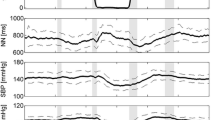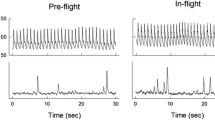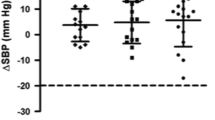Abstract
The review presents literature sources confirming the key aspects of the theory of allostasis and its relationship with the theory of homeostasis, as well as some neurophysiological aspects of allostatic systems, which include autonomic regulation, which determine the relationship between the brain and the cardiovascular system. One of the aspects of allostatic regulation is heart rate variability, which reflects the state of the body’s plastic constants and their changes under space flight conditions.
Similar content being viewed by others
Notes
We assign this role to the cardiovascular system in view of the fact that it is a determining link in a number of so-called integrative functions of the body: physical performance, orthostatic and vestibulo-vegetative stability, thermoregulation, etc.
In cybernetics and management theory, setting (set point) is the target value for the essential system variable. The deviation of such a variable from the set value is the basis for error control regulation using a negative feedback.
REFERENCES
Cannon, W.B., Organization for physiological homeostasis, Physiol. Rev., 1929, vol. 9, no. 3, p. 399.
Asarian, L., Gloy, V., and Geary, N., Homeostasis, in Encyclopedia of Human Behavior, Academic, 2012, p. 324.
Cannon, W.B., The Wisdom of the Body, New York: W.W. Norton, 1932.
Goldstein, D.S., How does homeostasis happen? Integrative physiological, systems biological, and evolutionary perspectives, Am. J. Physiol.: Regul. Integr. Comp. Physiol., 2019, vol. 316, no. 4, p. R301.
Fisher, S. and Reason, J., Allostasis: a new paradigm to explain arousal pathology, Handbook of Life Stress, Cognition and Health, Fisher, S. and Reason, J., Eds., New York: Wiley, 1988, P. 629.
Sterling, P., Allostasis: a model of predictive regulation, Physiol. Behav., vol. 106, no. 1. P. 5.
Nosovsky, A.M., Larina, I.M., and Grigor’ev, A.I., Application of the principle of invariant relations for the development of quantitative assessment of homeostasis of human organism, Tekhnol. Zhivykh Sist., 2009, vol. 6, no. 5, p. 33.
Carlson, E.D. and Chamberlain, R.M., Allostatic load and health disparities: a theoretical orientation, Res. Nurs. Health, 2005, vol. 28, no. 4, p. 306.
McEwen, B.S. and Wingfiel, J.C., The concept of allostasis in biology and biomedicine, Horm. Behav., 2003, vol. 43, no. 1, p. 2.
Goldberge, A.L., Peng, C.K., and Lipsitz, L.A., What is physiologic complexity and how does it change with aging and disease? Neurobiol. Aging, 2002, vol. 23, no. 1, p. 23.
Plsek, P., Redesigning healthcare with insights from the science of complex adaptive systems, in Crossing the Quality Chasm: a New Health System for the 21st Century, Washington, D.C.: National Academy Press, 2001, p. 309.
McEwen, B.S., Interacting mediators of allostasis and allostatic load: towards an understanding of resilience in aging, Metabolism, 2003, vol. 52, no. 10, suppl. 2, p. 10.
Damasio, A., Descartes’ Error: Emotion, Reason, and the Human Brain, New York: Putnam, 2005.
Jänig, W., The integrative action of the autonomic nervous system, Neurobiology of Homeostasis, New York: Cambridge University Press, 2006, p. 610.
Thayer, J.F., Ahs, F., Fredrickson, M., et al., A meta-analysis of heart rate variability and neuroimaging studies: implications for heart rate variability as a marker of stress and health, Neurosci. Biobehav. Rev., 2012, vol. 36, no. 2, p. 747.
Thayer, J.F. and Sternberg, E., Beyond heart rate variability: vagal regulation of allostatic systems, Ann. N.Y. Acad. Sci., 2006, vol. 1088, p. 361.
Viljoen, M. and Claassen, N., Allostatic load and heart rate variability as health risk indicators, Afr. Health Sci., 2017, vol. 17, no. 2, p. 428.
Corrigan, S.L., Roberts, S., Warmington, S., et al., Monitoring stress and allostatic load in first responders and tactical operators using heart rate variability: a systematic review, BMC Public Health, 2021, vol. 21, no. 1, p. 1701.
Jose, A.D. and Collison, D., The normal range and determinants of the intrinsic heart rate in man, Cardiovasc. Res., 1970, vol. 4, no. 2, p. 160.
Pokrovskii, V.M., Formirovanie ritma serdtsa v organizme cheloveka i zhivotnykh (Formation of Heart Rhythm in the Humans and Animals), Krasnodar: Kuban’-Kniga, 2007.
Berntson, G.G., Bigger, J.T., Jr., Eckberg, D.L., et al., Heart rate variability: origins, methods, and interpretive caveats, Psychophysiology,1997, vol. 34, no. 6, p. 623.
Benarroch, E.E., The central autonomic network: functional organization, dysfunction, and perspective, Mayo Clin. Proc., 1993, vol. 68, no. 10, p. 988.
Smit, R., Thayer, J.F., Khals, S.S., and Lane, R.D., The hierarchical basis of neurovisceral integration, Neurosci. Biobehav. Rev., 2017, vol. 75, p. 274.
Sklerov, M., Dayan, E., and Browne, N., Functional neuroimaging of the central autonomic network: recent developments and clinical implications, Clin. Auton. Res., 2019, vol. 29, no. 6, p. 555.
Shouman, K. and Benarroch, E.E., Central autonomic network, in Autonomic Nervous System and Sleep, Springer-Verlag, 2021, p. 9.
Saper, C.B., The central autonomic nervous system: conscious visceral perception and autonomic pattern generation, Annu. Rev. Neurosci., 2002, vol. 25, p. 433.
Thayer, J.F., Sollers, J.J., Labiner, D.M., et al., Age-related differences in prefrontal control of heart rate in humans: a pharmacological blockade study, Int. J. Psychophysiol., 2009, vol. 72, no. 1, p. 81.
Palma, J.A. and Benarroch, E.E., Neural control of the heart: recent concepts and clinical correlations, Neurology, 2014, vol. 83, no. 3, p. 261.
McEwen, B.S., Nasca, C., and Gray, J.D., Stress effects on neuronal structure: hippocampus, amygdala, and prefrontal cortex, Neuropsychopharmacology, 2016, vol. 41, no. 1, p. 3.
Joëls, M. and Baram, T.Z., The neuro-symphony of stress, Nat. Rev. Neurosci., 2009, vol. 10, no. 6, p. 459.
De Kloet, E.R., Joëls, M., and Holsboer, F., Stress and the brain: from adaptation to disease, Nat. Rev. Neurosci., 2005, vol. 6, no. 6, p. 463.
Karlamangla, A.S., Singer, B.H., McEwen, B.S., et al., Allostatic load as a predictor of functional decline: MacArthur studies of successful aging, J. Clin. Epidemiol., 2002, vol. 55, no. 7, p. 696.
McEwen, B.S., Sex, stress and the hippocampus: allostasis, allostatic load and the aging process, Neurobiol. Aging, 2002, vol. 23, no. 5, p. 921.
Arminjon, M., Birth of the allostatic model: from Cannon’s biocracy to critical physiology, J. Hist. Biol., 2016, vol. 49, no. 2, p. 397.
Vinogradova, O.L., Tomilovskaya, E.S., and Kozlovskaya, I.B., Gravity factor as the basis for the evolutionary adaptation of animal organisms to terrestrial conditions, Aviakosm. Ekol. Med., 2020, vol. 54, no. 6, p. 5.
Gauer, O.H. and Thorn, H.L., Postural changes in the circulation, in Handbook of Physiology, sec. 2: Circulation, Baltimore: Williams and Wilkins, 1965, vol. 3, p. 2409.
Osadchii, L.I., Polozhenie tela i regulyatsiya krovoobrashcheniya (Body Position and Regulation of Blood Circulation), Leningrad: Nauka, 1982.
Gazenko, O.G., Grigor’ev, A.I., and Egorov, A.D., Medical research under the program of long-term manned flights on the Salyut-7 orbital complex Soyuz-T, Kosm. Biol. Aviakosm. Med., 1990, vol. 24, no. 2, p. 9.
Buravkova, L., Larina, I., Andreeva, E., and Grigoriev, A., Microgravity effects on the matrisome, Cells, 2021, vol. 10, no. 9, p. 2226.
Iatridis, J.C., MacLean, J.J., Roughley, P.J., and Alini, M., Effects of mechanical loading on intervertebral disc metabolism in vivo, J. Bone Joint Surg. Am., 2006, vol. 88, no. 2, p. 41.
Swaminathan, V. and Gloerich, M., Decoding mechanical cues by molecular mechanotransduction, Curr. Opin. Cell Biol., 2021, vol. 72, p. 72.
Mrkonjic, S., Destaing, O., and Albiges-Rizo, C., Mechanotransduction pulls the strings of matrix degradation at invadosome, Matrix Biol., 2017. vols. 57—58, p. 190.
Yamashiro, Y. and Yanagisawa, H., The molecular mechanism of mechanotransduction in vascular homeostasis and disease, Clin. Sci. (London), 2020, vol. 134, no. 17, p. 2399.
Ando, J. and Yamamoto, K., Hemodynamic forces, endothelial mechanotransduction, and vascular diseases, Magn. Reson. Med. Sci., 2022, vol. 21, no. 2, p. 258.
Davis, M.J., Earley, S., Li, Y.S., and Chien, S., Vascular mechanotransduction, Physiol. Rev., 2023, vol. 103, no. 2, p. 1247.
Gazenko, O.G., Grigor’ev, A.I., and Natochin, Yu.V., Water—salt homeostasis and weightlessness, Kosm. Biol. Aviakosm. Med., 1980, vol. 14, no. 5, p. 3.
Grigor’ev, A.I., Larina, I.M., and Noskov, V.B., The influence of space flights on water-electrolytes turnover and its regulation, Ross. Fiziol. Zh. im. I.M. Sechenova, 2006, vol. 92, no. 1, p. 5.
Noskov, V.B., The state of water-salt metabolism, in Orbital’naya stantsiya “Mir” (Mir Orbital Station), Moscow: Inst. Med.-Biol. Probl., 2001, vol. 1, p. 599.
Noskov, V.B., Redistribution of liquid media of the body under conditions of weightlessness and simulating it impacts, Aviakosm. Ekol. Med., 2011, vol. 45, no. 1, p. 17.
Noskov, V.B., Adaptation of the water-electrolyte metabolism to space flight and at its imitation, Hum. Physiol., 2013, vol. 39, no. 5, p. 551. https://doi.org/10.1134/S0362119713050113
Hargens, A.R. and Richardson, S., Cardiovascular adaptations, fluid shifts, and countermeasures related to space flight, Respir. Physiol. Neurobiol., 2009, vol. 169, no. 1, p. 30.
Hughson, R.L., Helm, A., and Durante, M., Heart in space: effect of the extraterrestrial environment on the cardiovascular system, Nat. Rev. Cardiol., 2018, vol. 15, no. 3, p. 167.
Petersen, L.G., Damgaard, M., Petersen, J.C., and Norsk, P., Mechanisms of increase in cardiac output during acute weightlessness in humans, J. Appl. Physiol., 2011, vol. 111, no. 2, p. 407.
Tank, J. and Jordan, J., Mighty hearts in space, J. Physiol., 2015, vol. 593, no. 3, p. 485.
Aubert, A.E., Larina, I., Momken, I., et al., Towards human exploration of space: the THESEUS review series on cardiovascular, respiratory, and renal research priorities, NPJ Microgravity, 2016, vol. 2, p. 16031.
Baranov, V.M. and Donina, Zh.A., Modeling the relationships between respiratory biomechanics and hemodynamics in normal gravity and weightlessness, Ul’yanovsk. Med.-Biol. Zh., 2015, no. 1, p. 144.
Buckey, J.C., Gaffney, F.A., Lane, L.D., et al., Central venous pressure in space, N. Engl. J. Med., 1993, vol. 328, no. 2, p. 1853.
Norsk, P., Adaptation of the cardiovascular system to weightlessness: surprises, paradoxes and implications for deep space missions, Acta Physiol., 2020, vol. 228, no. 3, p. e13434.
Estenne, M., Gorini, M., Van Muylem, A., et al., Rib cage shape and motion in microgravity, J. Appl. Physiol., 1992, vol. 73, no. 3, p. 946.
Buckey, J.C., Gaffney, F.A., Lane, L.D., et al., Central venous pressure in space, J. Appl. Physiol., 1996, vol. 81, no. 1, p. 19.
Hughson, R.L., Recent findings in cardiovascular physiology with space travel, Respir. Physiol. Neurobiol., 2009, vol. 169, suppl. 1, p. 38.
Hughson, R.L., Helm, A., and Durante, M., Heart in space: effect of the extraterrestrial environment on the cardiovascular system, Nat. Rev. Cardiol., 2018, vol. 15, no. 3, p. 167.
Grigor’ev, A.I. and Egorov, A.D., Theory and practice of medical control during long-term space flights, Aviakosm. Ekol. Med., 1997, vol. 31, no. 1, p. 14.
Grigor’ev, A.I. and Baevskii, R.M., Kontseptsiya zdorov’ya i problema normy v kosmicheskoi meditsine (The Concept of Health and the Problem of Norms in Space Medicine), Moscow: Slovo, 2001.
Grigor’ev, A.I. and Baevskii, R.M., Kontseptsiya zdorov’ya i kosmicheskaya meditsina (Concept of Health and Space Medicine), Moscow: Slovo, 2007.
Crucian, B., Stowe, R.P., Mehta, S., et al., Alterations in adaptive immunity persist during long-duration spaceflight, NPJ Microgravity, 2015, vol. 1, p. 15013.
Van Ombergen, A., Laureys, S., Sunaert, S., et al., Spaceflight-induced neuroplasticity in humans as measured by MRI: what do we know so far? NPJ Microgravity, 2017, vol. 3, p. 2.
Roberts, D.R., Albrecht, M.H., Collins, H.R., et al., Effects of spaceflight on astronaut brain structure as indicated on MRI, N. Engl. J. Med., 2017, vol. 377, no. 18, p. 1746.
Fomina, E.V., Lysova, N.Y., Kukoba, T.B., et al., One-year mission on ISS is a step towards interplanetary missions, Aerosp. Med. Hum. Perform., 2017, vol. 88, no. 12, p. 1094.
Grigor’ev, A.I. and Egorov, A.D., Regulation of the human cardiovascular system under microgravitation, Vestn. Ross. Akad. Med. Nauk, 2002, no. 6, p. 52.
Gundel, A., Drescher, J., Spatenko, Y.A., and Polyakov, V.V., Changes in basal heart rate in spaceflights up to 438 days, Aviat. Space Environ. Med., 2002, vol. 73, no. 1, p. 17.
Vandeput, S., Widjaja, D., Aubert, A.E., and van Huffel, S., Adaptation of autonomic heart rate regulation in astronauts after spaceflight, Med. Sci. Monit., 2013, vol. 19, p. 9.
Parin, V.V., Baevskii, R.M., Volkov, Yu.N., and Gazenko, O.G., Kosmicheskaya kardiologiya (Space Cardiology), Leningrad: Meditsina, 1967.
Baevsky, R.M., Funtova, I.I., Luchitskaya, E.S., and Chernikova, A.G., The effects of long-term microgravity on autonomic regulation of blood circulation in crewmembers of the International Space Station, Cardiometry, 2014, no. 5, p. 35.
Baevskii, R.M., Current problems of space cardiology, Aviakosm. Ekol. Med., 2008, vol. 42, no. 6, p. 19.
Baevsky, R.M. and Nikulina, G.A., Holter monitoring in space medicine: analysis of heart rate variability, Vestn. Aritmol., 2000, no. 16, p. 6.
Baevskii, R.M., Analysis of heart rate variability in space medicine, Hum. Physiol., 2002, vol. 28, no. 2, p. 202.
Baevskii, R.M., The problem of assessing and predicting the functional state of the body and its development in space medicine, Usp. Fiziol. Nauk, 2006, vol. 37, no. 3, p. 42.
Baevskii, R.M., Funtova, I.I., Gharib, C., and Fortrat, J.-O., A comprehensive study of the autonomic regulation of blood pressure and heart rate in humans during prolonged exposure to weightlessness, in Orbital’naya stantsiya “Mir”: mediko-biologicheskie eksperimenty (Mir Orbital Station: Medical and Biological Experiments), Moscow: Inst. Med.-Biol. Probl., 2001, vol. 2, p. 541.
Baevskii, R.M., Polyakov, V.V., Moser, M., et al., Adaptation of the blood circulatory system to conditions of long-term weightlessness: ballistocardiographic studies during a 14-month space flight, Aviakosm. Ekol. Med., 1998, vol. 32, no. 3, p. 23.
Baevsky, R.M., Moser, M., Nikulina, G.A., et al., Autonomic regulation of circulation and cardiac contractility during a 14-month space flight, Acta Astronaut., 1998, vol. 42, nos. 1—8, p. 159.
Baevsky, R.M., Baranov, V.M., Funtova, I.I., et al., Autonomic cardiovascular and respiratory control during prolonged spaceflights aboard the International Space Station, J. Appl. Physiol., 2007, vol. 103, no. 1, p. 156.
Baevsky, R.M., Funtova, I.I., Diedrich, A. et al., Autonomic function testing aboard the ISS using “Pneumocard”, Acta Astronaut., 2009, vol. 65, p. 930.
Baevskii, R.M., Luchitskaya, E.S., Funtova, I.I., and Chernikova, A.G., Study of the autonomic regulation of blood circulation during a long-term space flight, Hum. Physiol., 2013, vol. 39, no. 5, p. 486. https://doi.org/10.1134/S0362119713050046
Otsuka, K., Cornelissen, G., Kubo, Y., et al., Anti-aging effects of long-term space missions, estimated by heart rate variability, Sci. Rep., 2019, vol. 9, no. 1, p. 8995.
Otsuka, K., Cornelissen, G., Furukawa, S., et al., Astronauts well-being and possibly anti-aging improved during long-duration spaceflight, Sci. Rep., 2021, vol. 11, no. 1, p. 14907.
Li, G. and He, H., Hormesis, allostatic buffering capacity and physiological mechanism of physical activity: a new theoretic framework, Med. Hypotheses, 2009, vol. 72, no. 5, p. 527.
McEwen, B., Stress, definition and concepts, Encyclopedia of Stress, Fink, G., Ed., San Diego, CA: Academic, 2000, vol. 3. p, 508.
Sy, M.R., Keefe, J.A., Sutton, J.P., and Wehrens, X.H.T., Cardiac function, structural, and electrical remodeling by microgravity exposure, Am. J. Physiol.: Heart Circ. Physiol., 2023, vol. 324, no. 1, p. H1.
Doroshin, A., Jillings, S., Jeurissen, B., et al., Brain connectometry changes in space travelers after long-duration spaceflight, Front. Neural Circuits, 2022, vol. 16, p. 815838.
Zu Eulenburg, P., Buchheim, J., Ashton, N.J., et al., Changes in blood biomarkers of brain injury and degeneration following long-duration spaceflight, JAMA Neurol., 2021, vol. 78, no. 12, p. 1525.
Garrett-Bakelman, F.E., Darshi, M., Green, S.J., et al., The NASA Twins Study: a multidimensional analysis of a year-long human spaceflight, Science, 2019, vol. 364, no. 6436, p. eaau8650.
Tzanetakou, I.P., Katsilambros, N.L., Benetos, A., et al., “Is obesity linked to aging?”: adipose tissue and the role of telomeres, Ageing Res. Rev., 2012, vol. 11, no. 2, p. 220.
Otsuka, K., Cornelissen, G., Furukawa, S., et al., Unconscious mind activates central cardiovascular network and promotes adaptation to microgravity possibly anti-aging during 1-year-long spaceflight, Sci. Rep., 2022, vol. 12, no. 1, p. 11862.
Egorov, A.D., Qualification of human body reactions developing in microgravity conditions, Aviakosm. Ekol. Med., 1996, vol. 30, no. 4, p. 14.
Grigor'ev, A.I. and Egorov, A.D., Mechanisms of homeostasis during prolonged exposure to microgravity, Aviakosm. Ekol. Med., 1998, vol. 32, no. 6, p. 20.
Baevskii, R.M., Matematicheskii analiz izmenenii serdechnogo ritma pri stresse (Mathematical Analysis of Changes in Heart Rate under Stress), Moscow: Nauka, 1984.
Larina, I.M., Nosovsky, A.M., and Rusanov, V.B., Holism and reductionism in physiology, Hum. Physiol., 2022, vol. 48, no. 3, p. 346. https://doi.org/10.1134/S036211972201008X
Acevedo, A. and Androulakis, I.P., Allostatic breakdown of cascading homeostat systems: a computational approach, Heliyon, 2017, vol. 3, no. 7, p. e00355.
Funding
The review was prepared within Russian Academy of Sciences topics 64.1 and 65.3 for 2013–2023.
Author information
Authors and Affiliations
Corresponding author
Ethics declarations
ETHICS APPROVAL AND CONSENT TO PARTICIPATE
Not applicable.
CONFLICT OF INTEREST
The authors of this work declare that they have no conflicts of interest.
Additional information
Publisher’s Note.
Pleiades Publishing remains neutral with regard to jurisdictional claims in published maps and institutional affiliations.
Rights and permissions
About this article
Cite this article
Rusanov, V.B., Larina, I.M. & Nosovsky, A.M. The Concept of Allostasis and Autonomic Regulation in Space Flight. Hum Physiol 49, 699–708 (2023). https://doi.org/10.1134/S0362119723700470
Received:
Revised:
Accepted:
Published:
Issue Date:
DOI: https://doi.org/10.1134/S0362119723700470




